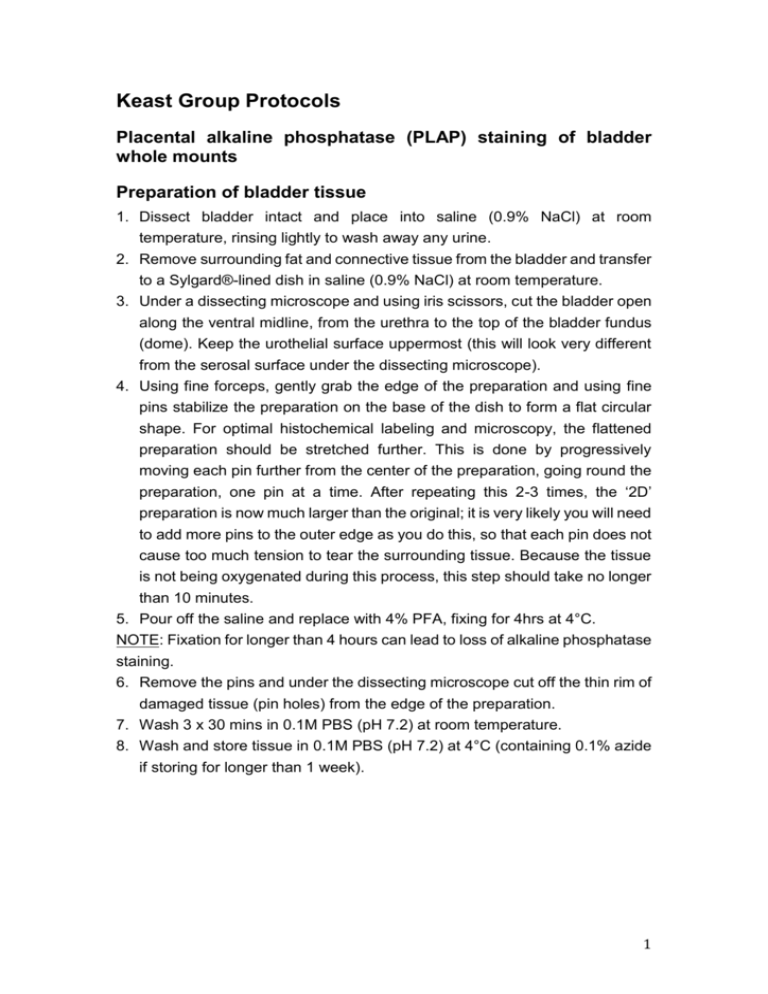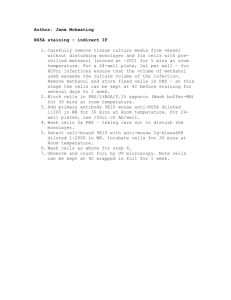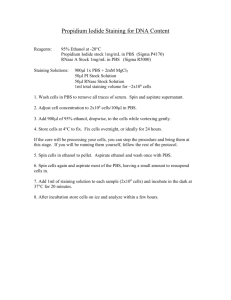Word docx
advertisement

Keast Group Protocols Placental alkaline phosphatase (PLAP) staining of bladder whole mounts Preparation of bladder tissue 1. Dissect bladder intact and place into saline (0.9% NaCl) at room temperature, rinsing lightly to wash away any urine. 2. Remove surrounding fat and connective tissue from the bladder and transfer to a Sylgard®-lined dish in saline (0.9% NaCl) at room temperature. 3. Under a dissecting microscope and using iris scissors, cut the bladder open along the ventral midline, from the urethra to the top of the bladder fundus (dome). Keep the urothelial surface uppermost (this will look very different from the serosal surface under the dissecting microscope). 4. Using fine forceps, gently grab the edge of the preparation and using fine pins stabilize the preparation on the base of the dish to form a flat circular shape. For optimal histochemical labeling and microscopy, the flattened preparation should be stretched further. This is done by progressively moving each pin further from the center of the preparation, going round the preparation, one pin at a time. After repeating this 2-3 times, the ‘2D’ preparation is now much larger than the original; it is very likely you will need to add more pins to the outer edge as you do this, so that each pin does not cause too much tension to tear the surrounding tissue. Because the tissue is not being oxygenated during this process, this step should take no longer than 10 minutes. 5. Pour off the saline and replace with 4% PFA, fixing for 4hrs at 4°C. NOTE: Fixation for longer than 4 hours can lead to loss of alkaline phosphatase staining. 6. Remove the pins and under the dissecting microscope cut off the thin rim of damaged tissue (pin holes) from the edge of the preparation. 7. Wash 3 x 30 mins in 0.1M PBS (pH 7.2) at room temperature. 8. Wash and store tissue in 0.1M PBS (pH 7.2) at 4°C (containing 0.1% azide if storing for longer than 1 week). 1 Staining of tissue 1. Wash tissue 3 x 10 mins in 0.1M PBS (pH 7.2) at room temperature. 2. Heat inactivate endogenous alkaline phosphatase by incubating the tissue in pre-heated 0.1M PBS (pH 7.2) at 72°C for 90 mins. 3. Rinse the tissue in Alkaline Phosphatase Buffer 1 x 5 mins, then 1 x 10 mins at room temperature. 4. Freshly prepare the Staining Solution by adding 20μl of NBT/BCIP Stock Solution (Roche, Cat# 1681451) per 1 ml of Alkaline Phosphatase Buffer. Incubate the tissue in Staining Solution for ~4hrs at room temperature or until developed sufficiently. 5. Rinse 3 x 10 mins in 0.1M PBS (pH 7.2) at room temperature. 6. (Optional: Clear background staining by incubating the tissue in 100% ethanol for 5-10 mins at room temperature or until background staining is sufficiently removed. Rinse slides 3 x 10 mins in 0.1M PBS (pH 7.2) at room temperature.) 7. Mount tissue onto 1% gelatinized slides and coverslip in buffered glycerol. Seal edges of coverslip with nail polish. Depending on your preference for viewing, urothelium surface can be mounted at the top or bottom. Solutions Solutions A and B (below) are used for the making of PBS: Solution A: (0.2M): 24.0g NaH2PO4 / 1000 ml H2O Solution B: (0.2M): 28.4g Na2HPO4 / 1000 ml H2O Phosphate Buffered Saline (PBS) 0.1M (pH 7.2) 1. 140 ml Sol A + 360 ml Sol B + ~450 ml H2O + 8.5g NaCl. Dissolve. 2. pH to 7.2 with 1M NaOH/HCl 3. Make up to 1 litre with H2O Alkaline Phosphatase Buffer (pH 9.5) 12.11g Tris Base (100mM) 5.84g NaCl (100mM) 10.17g MgCl2.6H2O (50mM) Make up to 1 litre with H2O pH to 9.5 with 1M HCl 2


